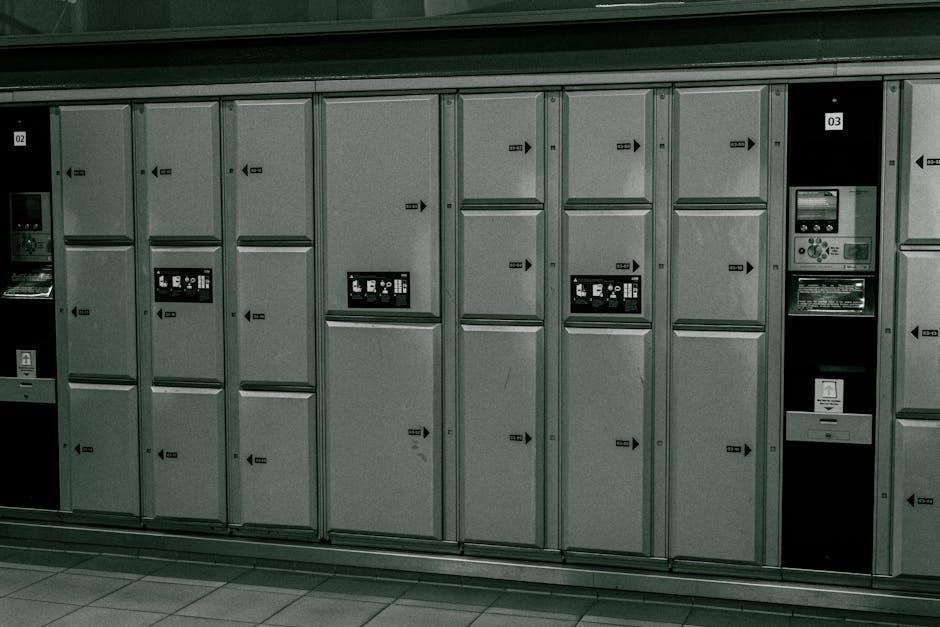Cell transport is a fundamental biological process essential for maintaining cellular homeostasis. The cell transport worksheet answer key PDF provides a comprehensive guide to understanding passive and active transport mechanisms, osmosis, and isotonic solutions. It offers detailed answers and explanations for common questions, helping students master key concepts like diffusion, membrane structure, and transport regulation. This resource is ideal for reinforcing classroom learning and preparing for assessments.
1.1 Importance of Cell Transport in Biology
Cell transport is vital for maintaining cellular homeostasis, enabling cells to exchange materials, waste, and signaling molecules. It ensures proper nutrient uptake, waste removal, and regulation of internal conditions. The cell transport worksheet answer key PDF highlights how transport mechanisms like diffusion, osmosis, and active transport are essential for cellular function. Understanding these processes is crucial for studying life processes, disease mechanisms, and drug delivery systems. These worksheets provide a structured way to learn and apply key biological concepts, making them indispensable for students and educators alike in grasping the fundamental role of transport in sustaining life and cellular operations.
1.2 Overview of the Cell Membrane
The cell membrane is a thin, semi-permeable structure that separates the cell from its environment, controlling the movement of substances in and out. Composed primarily of phospholipids and embedded proteins, it maintains cellular integrity and regulates transport. The cell transport worksheet answer key PDF emphasizes the membrane’s role in passive and active transport, ensuring cells acquire necessary nutrients and expel waste. Its fluid mosaic model allows dynamic movement of molecules, enabling functions like signaling and transport. Worksheets and answer keys provide detailed diagrams and explanations, helping students visualize and understand the membrane’s structure and its critical role in cellular function and survival.

Types of Cell Transport
Cell transport includes passive and active mechanisms. Passive involves diffusion and osmosis, while active requires energy and carrier proteins. The cell transport worksheet answer key PDF explains these processes clearly.
2.1 Passive Transport
Passive transport is the movement of molecules across the cell membrane without energy input. It includes diffusion, osmosis, and facilitated diffusion. Diffusion involves particles moving from high to low concentration until equilibrium. Osmosis is the diffusion of water through a semipermeable membrane. Facilitated diffusion uses carrier proteins to assist movement. The cell transport worksheet answer key PDF provides detailed explanations and examples of these processes, ensuring clarity for students. It also includes diagrams and practice questions to enhance understanding of how passive transport maintains cellular balance and regulates essential substances.
2.2 Active Transport
Active transport involves moving molecules against their concentration gradient, requiring energy, typically from ATP. This process is crucial for cells to accumulate essential nutrients or expel waste. The cell transport worksheet answer key PDF explains active transport mechanisms, such as the role of carrier proteins and ATP hydrolysis. It includes examples like sodium-potassium pumps and glucose absorption. Practice questions and diagrams help students differentiate active transport from passive processes, emphasizing its importance in maintaining cellular function and homeostasis. This resource ensures a thorough understanding of active transport’s energy-dependent nature and its vital role in cellular operations.

Passive Transport Mechanisms
Passive transport involves the movement of substances without energy input. It includes diffusion, osmosis, and facilitated diffusion. The cell transport worksheet answer key PDF provides detailed explanations and examples of these mechanisms, helping students understand how substances move across cell membranes naturally, from high to low concentration, ensuring proper cellular function and balance.
3.1 Diffusion
Diffusion is a type of passive transport where particles move naturally from an area of higher concentration to an area of lower concentration. This process is essential for cells to maintain equilibrium and proper function. The cell transport worksheet answer key PDF elaborates on diffusion, explaining its role in cellular respiration and the exchange of gases like oxygen and carbon dioxide. It also clarifies how diffusion differs from other transport mechanisms, making it easier for students to grasp the fundamental principles of molecular movement across cell membranes. Understanding diffusion is crucial for comprehending overall cell transport dynamics.
3.2 Osmosis
Osmosis is a specific type of diffusion involving water molecules moving across a semipermeable membrane. The cell transport worksheet answer key PDF highlights how osmosis regulates water balance within cells, influencing cell shape and turgor pressure. It explains isotonic, hypotonic, and hypertonic solutions, detailing their effects on cells. For example, in a hypotonic solution, water enters the cell, causing it to swell, while in a hypertonic solution, water exits, leading to shrinkage. This resource provides clear diagrams and examples to illustrate osmotic processes, ensuring students understand its significance in maintaining cellular health and function. Osmosis is vital for life, as it aids in nutrient absorption and waste removal.
3.3 Facilitated Diffusion
Facilitated diffusion is a type of passive transport that relies on membrane proteins to guide molecules across the cell membrane. The cell transport worksheet answer key PDF emphasizes that this process, like diffusion, moves substances from high to low concentration without energy. Carrier proteins bind to specific molecules, changing shape to transport them. Channel proteins form pores for water or ions. This method is crucial for glucose and ion transport. Worksheets often include diagrams labeling these proteins and their roles. Understanding facilitated diffusion is key to grasping how cells maintain equilibrium and meet metabolic needs efficiently. It ensures essential nutrients enter cells while waste products are removed, maintaining homeostasis.

Active Transport Processes
Active transport requires energy, often from ATP, to move molecules against concentration gradients. Carrier proteins play a key role in this process. The cell transport worksheet answer key PDF highlights examples like proton pumps and calcium transport, ensuring students grasp how cells maintain essential ion balances and nutrient uptake through this energy-dependent mechanism.
4.1 Definition and Examples
Active transport is the energy-dependent movement of molecules across a cell membrane against their concentration gradient. It requires ATP and carrier proteins. Examples include the sodium-potassium pump, which maintains ion balance, and calcium transport in muscle cells. The cell transport worksheet answer key PDF clarifies these concepts, ensuring students understand how cells use energy to transport essential nutrients and ions. This process is vital for cellular function, enabling the uptake of glucose and amino acids in certain tissues. By studying these examples, students can grasp the mechanisms and significance of active transport in maintaining cellular homeostasis and proper physiological functions.
4.2 Role of ATP in Active Transport
ATP plays a crucial role in active transport by providing the energy required to move molecules against their concentration gradient. The cell transport worksheet answer key PDF explains how ATP is hydrolyzed to release energy, which is then utilized by transport proteins. These proteins bind to specific molecules, enabling their translocation across the membrane. Without ATP, active transport cannot occur, as it depends entirely on this energy source. The PDF highlights key examples, such as the sodium-potassium pump, to illustrate ATP’s essential role in maintaining cellular ion balance and proper nerve function. This emphasizes ATP’s significance in active transport processes.

The Cell Membrane and Transport
The cell membrane is a selectively permeable barrier regulating the movement of substances. It controls ion and nutrient transport, ensuring proper cellular function and maintaining homeostasis through dynamic regulation.
5.1 Structure of the Cell Membrane
The cell membrane is a bilayer of phospholipids with embedded proteins, forming a fluid mosaic structure. This dynamic framework allows selective permeability, enabling substances like ions and glucose to pass through while maintaining cellular integrity. The hydrophilic (water-attracting) heads face outward, interacting with the cell’s aqueous environment, while the hydrophobic (water-repelling) tails form the inner layer. Cholesterol molecules are interspersed within the bilayer, stabilizing its structure and regulating fluidity. Proteins, such as channels and transporters, facilitate the movement of molecules across the membrane, playing a crucial role in cell transport mechanisms like diffusion and active transport. This structure ensures efficient regulation of materials entering and exiting the cell.
5.2 Role of Membrane in Regulating Transport
The cell membrane plays a pivotal role in regulating transport by controlling the movement of substances in and out of the cell. Its selective permeability allows certain molecules to pass while restricting others, ensuring the cell maintains homeostasis. The membrane regulates passive transport, such as diffusion and osmosis, by facilitating the movement of molecules without energy. For active transport, the membrane utilizes proteins and ATP to transport molecules against concentration gradients. This regulation ensures the cell’s internal environment remains balanced, essential for proper functioning. The membrane’s structure, including embedded proteins and lipid composition, is crucial for these transport processes, making it a dynamic gatekeeper of cellular activity.

Transport Across the Cell Membrane
Transport across the cell membrane is crucial for cellular function. It involves passive transport (diffusion, osmosis) and active transport, requiring energy. Isotonic, hypotonic, and hypertonic solutions affect water movement, influencing cell shape and function. This process ensures proper exchange of nutrients, waste, and signaling molecules, maintaining cellular homeostasis.
6.1 Isotonic, Hypotonic, and Hypertonic Solutions
Isotonic, hypotonic, and hypertonic solutions differ in solute concentration relative to the cell. Isotonic solutions have equal solute concentration, causing no net water movement. Hypotonic solutions have lower solute concentration, leading cells to swell due to water influx. Hypertonic solutions have higher solute concentration, causing water to leave the cell, potentially shrinking it. These concepts are vital in understanding osmosis and cell transport, as they determine water balance and cellular shape. Worksheets often include questions on predicting cell behavior in these solutions, reinforcing the principles of passive transport and membrane permeability.
6.2 Effects on Cell Shape and Function
Isotonic, hypotonic, and hypertonic solutions significantly impact cell shape and function. In isotonic environments, cells maintain their shape and normal function due to balanced water flow. In hypotonic solutions, cells swell and may burst (lysis) if they cannot regulate the influx of water. For animal cells, this can lead to rupture, while plant cells may become turgid. Conversely, in hypertonic solutions, cells lose water, shrink, and may become flaccid, disrupting normal metabolic functions. These changes highlight the importance of osmotic balance in cellular health and function, often tested in worksheets to assess understanding of transport mechanisms and their biological implications.

Cell Transport Worksheets
Cell transport worksheets provide interactive exercises to understand transport mechanisms. They include questions on diffusion, osmosis, and active transport, along with answer keys for self-assessment and improvement.
7.1 Purpose of Worksheets in Learning
Worksheets are essential tools for reinforcing concepts in cell transport. They help students apply theoretical knowledge through practical exercises, such as labeling diagrams or completing tables. By engaging with these activities, learners can identify gaps in their understanding and improve retention of key ideas. Worksheets also encourage critical thinking and problem-solving skills, which are vital for mastering complex topics like active transport and osmosis. The inclusion of answer keys allows for self-assessment, enabling students to track their progress and review challenging concepts independently. This hands-on approach complements traditional teaching methods and enhances overall learning effectiveness in biology education.
7.2 Key Concepts Covered in Worksheets
Cell transport worksheets cover a variety of fundamental concepts, ensuring a thorough understanding of biological processes. Topics include types of transport, such as passive and active transport, and their mechanisms. Worksheets often focus on diffusion, osmosis, and facilitated diffusion, with exercises that require students to distinguish between these processes. Additionally, they address isotonic, hypotonic, and hypertonic solutions, helping learners understand their effects on cells. Vocabulary practice and diagram labeling are common features, reinforcing terminology and visual recognition. These exercises are designed to build a strong foundation, enabling students to apply their knowledge in more complex biological contexts effectively.

Answer Key for Cell Transport Worksheets
The cell transport worksheet answer key PDF provides clear, accurate solutions to exercises, ensuring students grasp concepts like diffusion, osmosis, and active transport. It aids in self-assessment and understanding.
8.1 Common Questions and Answers
Common questions in cell transport often focus on distinguishing passive and active transport, understanding osmosis, and identifying isotonic solutions. The cell transport worksheet answer key PDF addresses these topics, providing clear explanations. For instance, it explains how facilitated diffusion differs from simple diffusion and the role of ATP in active transport. Students frequently ask about the effects of hypotonic and hypertonic solutions on cell shape, which the PDF clarifies with examples. Additionally, it covers membrane structure and transport regulation, offering detailed answers to questions about vesicle transport and equilibrium. This resource ensures comprehension of key concepts and prepares students for assessments effectively.
8.2 Reviewing Vocabulary and Definitions
Reviewing vocabulary is crucial for understanding cell transport. The cell transport worksheet answer key PDF includes definitions for key terms like diffusion, osmosis, and active transport. It explains how facilitated diffusion relies on membrane proteins and distinguishes it from simple diffusion. The PDF also clarifies terms like isotonic, hypotonic, and hypertonic solutions, explaining their effects on cells. Additionally, it defines equilibrium and the role of ATP in energy-dependent processes. By mastering these definitions, students build a solid foundation for understanding complex transport mechanisms, ensuring accurate completion of worksheets and assessments.
Understanding cell transport is vital for biology, as it explains how substances move across membranes, maintaining cellular function. The cell transport worksheet answer key PDF enhances learning by clarifying concepts.
9.1 Summary of Key Points
The cell transport worksheet answer key PDF highlights essential biological processes, including passive and active transport, diffusion, osmosis, and the role of the cell membrane. It emphasizes isotonic, hypotonic, and hypertonic solutions, explaining their effects on cell shape and function. Key concepts like facilitated diffusion, ATP’s role in active transport, and equilibrium are also covered. The resource clarifies how cells maintain homeostasis by regulating transport, ensuring proper cellular function. By reviewing these concepts, students gain a deeper understanding of cellular processes, enabling them to apply this knowledge in practical scenarios and assessments confidently.
9.2 Importance of Understanding Cell Transport
Understanding cell transport is crucial for grasping how cells function, interact with their environment, and maintain homeostasis. It provides insights into how nutrients, waste, and signaling molecules are exchanged, essential for life. This knowledge aids in understanding diseases like cystic fibrosis and diabetes, where transport mechanisms fail. It also underpins advancements in drug delivery and toxicology, as understanding how substances cross membranes is vital. Furthermore, it highlights the cell membrane’s dynamic role in regulating transport, emphasizing its importance in cellular health and function. Mastery of these concepts is foundational for biology and medicine, enabling better comprehension of life processes and their applications.

Additional Resources
Explore recommended cell transport worksheet answer key PDF guides for in-depth study. Utilize online tools for interactive practice, enhancing understanding of transport mechanisms and membrane functions effectively.

10.1 Recommended PDF Guides
Enhance your learning with the Cell Transport Review Key and Cell Transport Review Packet with answers PDFs. These guides offer comprehensive explanations, practice questions, and detailed diagrams to clarify concepts like passive and active transport. The Amoeba Sisters Video Recap: Cell Transport PDF provides an engaging visual review, while worksheets focus on specific topics such as isotonic solutions and membrane structure. These resources are ideal for self-study, classroom preparation, and reinforcing key biological principles. They ensure a thorough understanding of cell transport mechanisms and their significance in cellular functions.
10.2 Online Tools for Practice
Supplement your studies with interactive online tools designed to reinforce cell transport concepts. Websites offering cell transport worksheet answer key PDF downloads provide instant feedback and assessment. Platforms like Kahoot! and Quizlet feature quizzes on diffusion, osmosis, and active transport, making learning engaging. Virtual labs simulate experiments, such as observing osmotic changes in cells, allowing hands-on practice. These tools cater to diverse learning styles, ensuring a deeper grasp of transport mechanisms. Utilize these resources to test knowledge, identify weaknesses, and confidently master cell transport principles through dynamic and accessible learning experiences.



